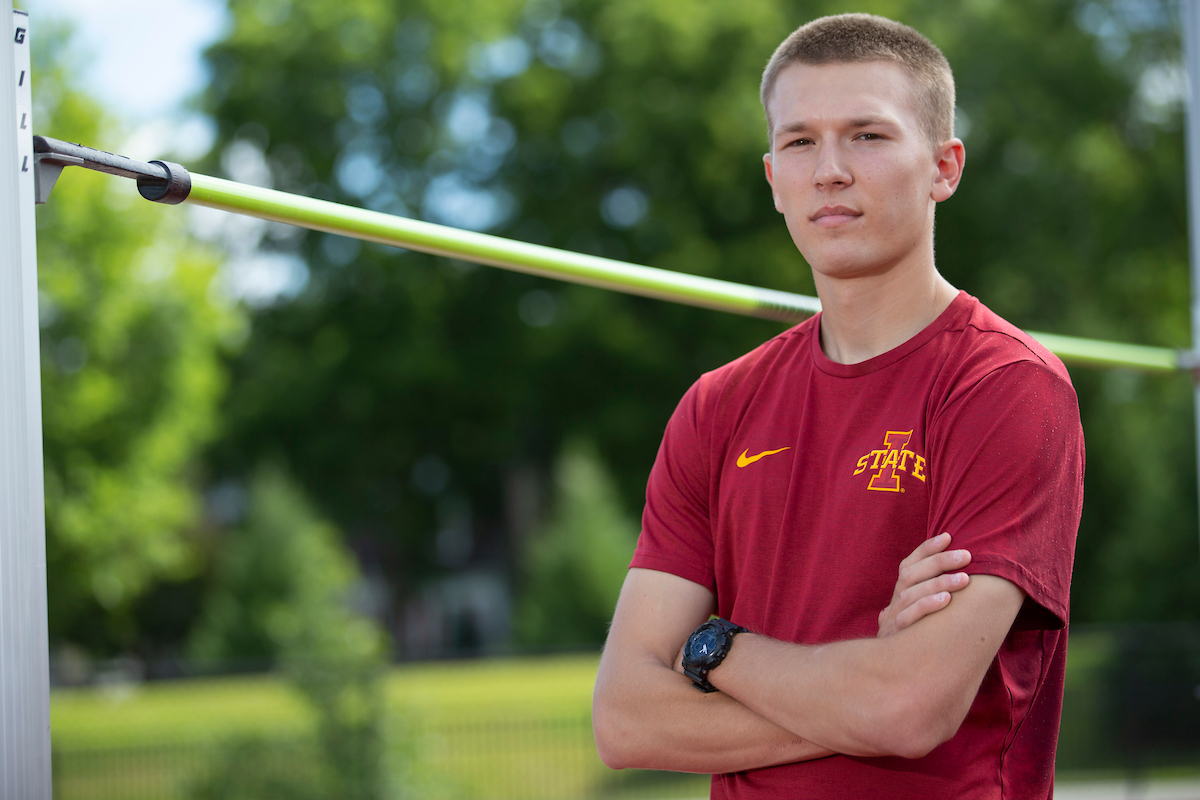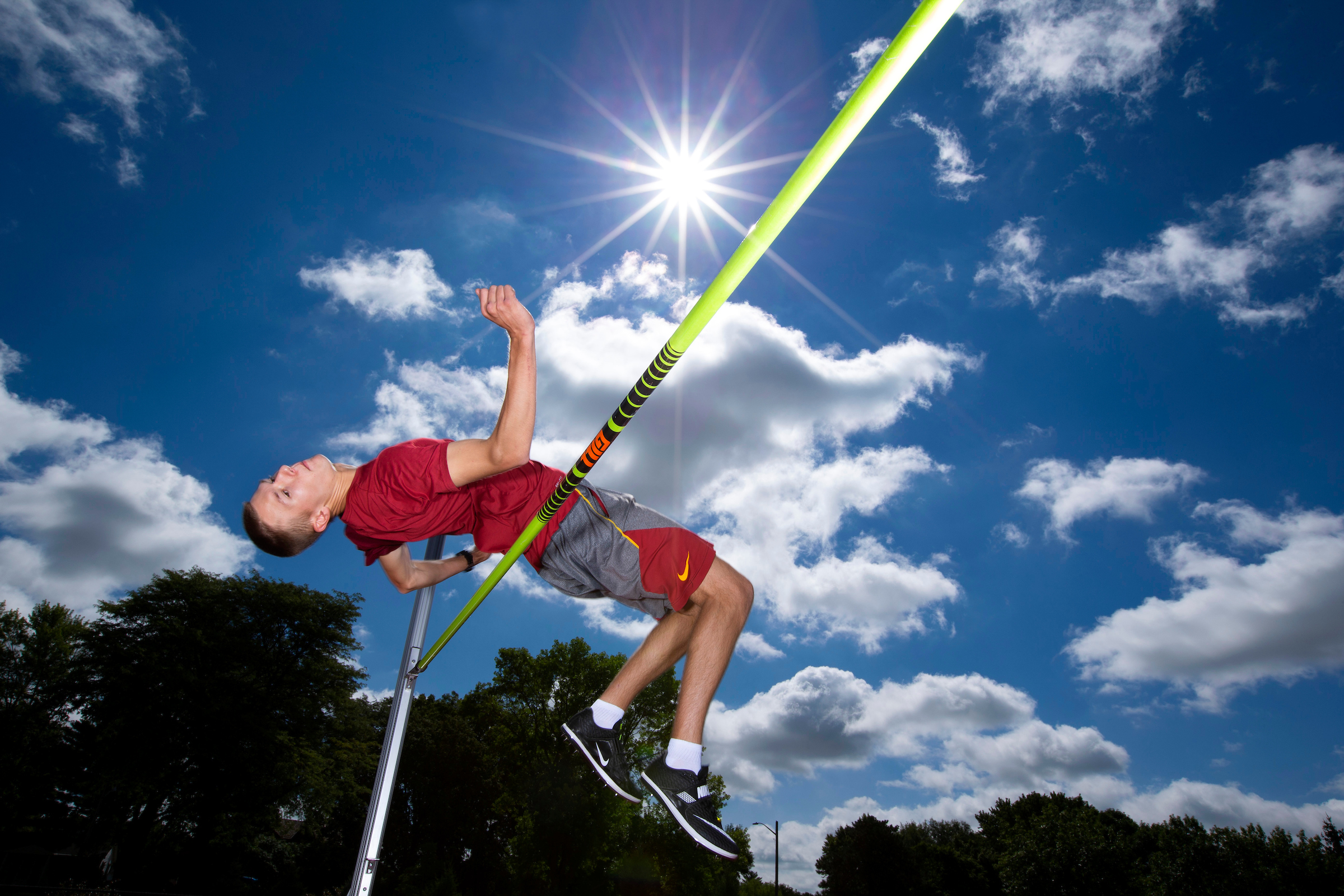Cody Durbin is a high achiever. Literally. As a sophomore in the 2018 Big 12 Conference Men’s Outdoor Track and Field Championships, he placed seventh in the high jump, clearing a height of 6 feet, 9 inches.
His Iowa State adventure is all about continually raising the bar. Durbin (’20 physics) is the rare combination of student-athlete and Army ROTC cadet, while also achieving academic honors in a demanding science major.
Iowa State never blinked at his ambition.
“I couldn’t see myself going to any other college and being able to do all three,” Durbin said. “I think Iowa State is unique. A lot of places you visit they would tell you, ‘You can’t do this, you can’t do this tough major,’ whereas Iowa State was just ‘You’ll be able to work it out.’”
He wakes up at 5:15 a.m. each morning for a day of Army physical training, physics and engineering classes, track practice and homework until 11 p.m. Then he repeats it all over.
“I couldn’t see myself going to any other college and being able to do all three. I think Iowa State is unique. A lot of places you visit they would tell you, ‘You can’t do this, you can’t do this tough major,’ whereas Iowa State was just ‘You’ll be able to work it out.’”
Nate Thomas, academic coordinator for Iowa State’s track and field, golf, tennis and wrestling programs, works with as many as 150 student-athletes each year. Durbin is his first student to also do ROTC, Thomas said, with the full support of Iowa State coaches.
“It has been a perfect fit for Cody in allowing him to get whatever he wants out of his college education and his time in Ames. I don’t think it would have been possible for him to do it anywhere else. At Iowa State, he has the support so he can get a good experience.”

A ‘down to earth’ campus visit
Durbin has always aimed for the top. In middle school, he stayed up late reading exercise science articles about how to taper programs and how to use plyometrics with weight programs.
He had a simple goal: jumping higher. Preferably to dunk in basketball, but he would take what he could get.
“I dunked in eighth grade for my first time. Too bad I wasn't very good, or otherwise I would be playing basketball,” he joked.
Then someone suggested trying the high jump.
“I tried it, and I was not that great,” he said. He points out that his younger sister was a better high jumper in a comparison of their eighth-grade years.
But he got better.
When he finished second in the Iowa High School State Championships during his junior year, Iowa State noticed. Iowa State was Durbin’s first college visit and the only big university campus he had ever seen. A first-generation college student, he instantly clicked with the coaches and campus.
“All of the people on my visit were down to earth and easy to get along with,” he said. “Whereas other colleges tried to put on a show, Iowa State was like ‘we’re just people, too.’”
Embracing challenge
First-year students can be concerned about tough course loads. Durbin, on the other hand, worried his major would not be challenging enough. During freshman orientation he made a jump to physics.
“I was good at math in high school. I thought, ‘Let’s challenge myself,’ and I thought [physics] always was interesting. There was more to learn in physics than anything else, I thought.”
Physics was perfect for Durbin’s love of logical thinking and problem-solving. It piqued his interest through courses such as classical mechanics. It was also an intriguing area of study for a high jumper.
Dick Fosbury, the 1968 Olympic gold medal winner in high jump, changed the track and field world forever with the “Fosbury flop,” a technique that is pure physics.
“The big thing about the Fosbury flop - with the arch in your back and the J-curve approach, you get your center of mass beneath the bar, but you still go over the bar,” Durbin said. “You think a lot about acceleration, and with acceleration you get force.”
Learning to lead
Technique is important, but mental toughness sets a high jumper apart.
“You’ve got to be mentally tough because you’re running full speed at a bar that’s over your head,” Durbin said. “The way the competition works, if you miss on your first try now you’re down a bar. So you come up and jump higher than your opponent to win. It’s all just mental.”
When Durbin joined Army ROTC his sophomore year, it was another tough challenge. It also turned into the best part of his Iowa State experience, he said.

“You’ve got to be mentally tough because you’re running full speed at a bar that’s over your head. The way the competition works, if you miss on your first try now you’re down a bar. So you come up and jump higher than your opponent to win. It’s all just mental.”
This summer he graduated from basic camp at Fort Knox, where he learned skills such as land navigation and squad tactics. He enjoys the focus on leadership and thinking differently in close teams.
“ROTC is a lot about learning to lead,” he said. “When you commission as a lieutenant, you’re in infantry, you might get a platoon. Leadership is something I can transfer over to track.”
He never saw himself as a leader before, but is forming a philosophy not unlike the high jump: show up, do what you’re supposed to do, do it as well as you can. Success will follow.
“The ROTC program at Iowa State is top-notch, so I’m pretty lucky,” Durbin said.
Jumping ahead
Durbin plans to pursue a master’s degree in electrical engineering during or after his military service and follow his passion for electric cars. His dad, who is a master auto technician, and his brother co-own a body shop.
Whatever he does, it is safe to say he will clear the bar.
